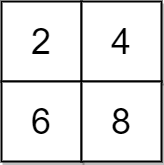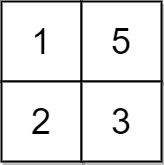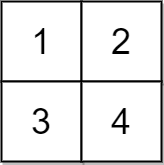原文链接: https://leetcode-cn.com/problems/minimum-operations-to-make-a-uni-value-grid
英文原文
You are given a 2D integer grid of size m x n and an integer x. In one operation, you can add x to or subtract x from any element in the grid.
A uni-value grid is a grid where all the elements of it are equal.
Return the minimum number of operations to make the grid uni-value. If it is not possible, return -1.
Example 1:

Input: grid = [[2,4],[6,8]], x = 2 Output: 4 Explanation: We can make every element equal to 4 by doing the following: - Add x to 2 once. - Subtract x from 6 once. - Subtract x from 8 twice. A total of 4 operations were used.
Example 2:

Input: grid = [[1,5],[2,3]], x = 1 Output: 5 Explanation: We can make every element equal to 3.
Example 3:

Input: grid = [[1,2],[3,4]], x = 2 Output: -1 Explanation: It is impossible to make every element equal.
Constraints:
m == grid.lengthn == grid[i].length1 <= m, n <= 1051 <= m * n <= 1051 <= x, grid[i][j] <= 104
中文题目
给你一个大小为 m x n 的二维整数网格 grid 和一个整数 x 。每一次操作,你可以对 grid 中的任一元素 加 x 或 减 x 。
单值网格 是全部元素都相等的网格。
返回使网格化为单值网格所需的 最小 操作数。如果不能,返回 -1 。
示例 1:

输入:grid = [[2,4],[6,8]], x = 2 输出:4 解释:可以执行下述操作使所有元素都等于 4 : - 2 加 x 一次。 - 6 减 x 一次。 - 8 减 x 两次。 共计 4 次操作。
示例 2:

输入:grid = [[1,5],[2,3]], x = 1 输出:5 解释:可以使所有元素都等于 3 。
示例 3:

输入:grid = [[1,2],[3,4]], x = 2 输出:-1 解释:无法使所有元素相等。
提示:
m == grid.lengthn == grid[i].length1 <= m, n <= 1051 <= m * n <= 1051 <= x, grid[i][j] <= 104
通过代码
高赞题解
要使任意两元素最终相等,这两元素的差必须是 $x$ 的倍数,否则无法通过加减 $x$ 来相等。我们可以以数组中的某一元素为基准,若所有元素与它的差均为 $x$ 的倍数,则任意两元素之差为 $x$ 的倍数。
假设要让所有元素均为 $y$,设小于 $y$ 的元素有 $p$ 个,大于 $y$ 的元素有 $q$ 个,可以发现:
- 若 $p<q$,$y$ 每增加 $x$,操作数就可以减小 $q-p$;
- 若 $p>q$,$y$ 每减小 $x$,操作数就可以减小 $p-q$;
因此 $p=q$ 时可以让总操作数最小,此时 $y$ 为所有元素的中位数。
func minOperations(grid [][]int, x int) (ans int) {
n := len(grid) * len(grid[0])
a := make([]int, 0, n)
for _, row := range grid {
for _, v := range row {
if (v-grid[0][0])%x != 0 { // 以其中一元素为基准,若所有元素与它的差均为 x 的倍数,则任意两元素之差为 x 的倍数
return -1
}
}
a = append(a, row...)
}
sort.Ints(a) // 除了排序,也可以用求第 k 大算法来找中位数
for _, v := range a {
ans += abs(v-a[n/2]) / x
}
return
}
func abs(x int) int {
if x < 0 {
return -x
}
return x
}统计信息
| 通过次数 | 提交次数 | AC比率 |
|---|---|---|
| 4379 | 11070 | 39.6% |
提交历史
| 提交时间 | 提交结果 | 执行时间 | 内存消耗 | 语言 |
|---|




